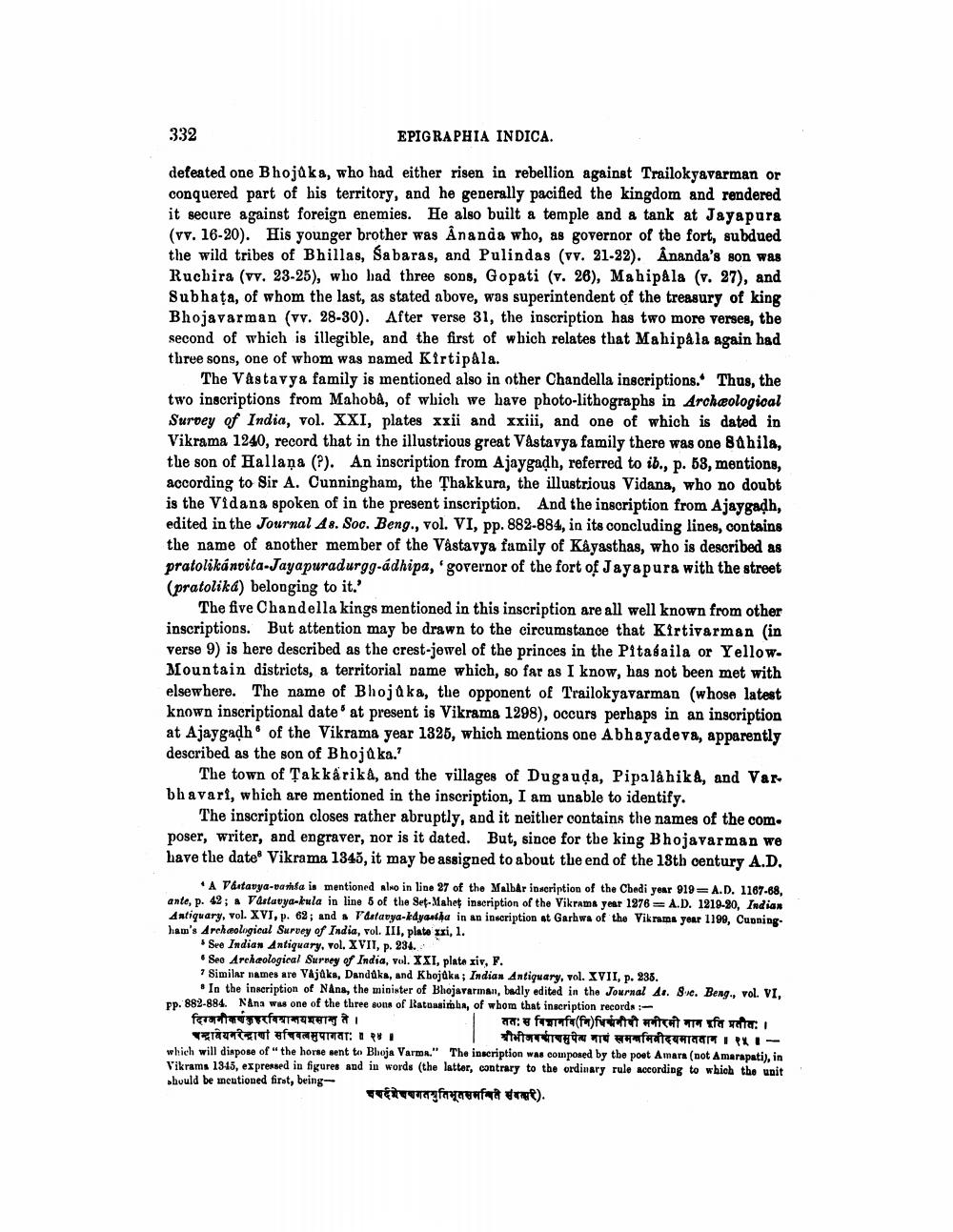________________
332
EPIGRAPHIA INDICA.
defeated one Bhojáka, who had either risen in rebellion against Trailokyavarman or conquered part of his territory, and he generally pacified the kingdom and rendered it secure against foreign enemies. He also built a temple and a tank at Jayapura (vv. 16-20). His younger brother was Ananda who, as governor of the fort, subdued the wild tribes of Bhillas, Sabaras, and Pulindas (vv. 21-22). Ånanda's son was Ruchira (vv. 23-25), who had three sons, Gopati (v. 26), Mahipala (v. 27), and Subhata, of whom the last, as stated above, was superintendent of the treasury of king Bhojavarman (vv. 28-30). After verse 31, the inscription has two more verses, the second of which is illegible, and the first of which relates that Mahipala again had three sons, one of whom was named Kirtipäla.
The Vastavya family is mentioned also in other Chandella inscriptions. Thus, the two inscriptions from Mahoba, of which we have photo-lithographs in Archeological Survey of India, vol. XXI, plates xxi and xxiii, and one of which is dated in Vikrama 1240, record that in the illustrious great Vastavya family there was one 8 hila, the son of Hallana (R). An inscription from Ajaygadh, referred to ib., p. 68, mentions, according to Sir A. Cunningham, the Thakkura, the illustrious Vidana, who no doubt is the Vidana spoken of in the present inscription. And the inscription from Ajaygadh, edited in the Journal A 8. Soc. Beng., vol. VI, pp. 882-884, in its concluding lines, contains the name of another member of the Vastavya family of Kayasthas, who is described as pratolikánvita-Jayapuradurgg-ádhipa, 'governor of the fort of Jayapura with the street (pratoliká) belonging to it.
The five Chandella kings mentioned in this inscription are all well known from other inscriptions. But attention may be drawn to the circumstance that Kirtivarman (in verse 9) is here described as the crest-jewel of the princes in the Pitasaila or Yellow. Mountain districts, a territorial name which, so far as I know, has not been met with elsewhere. The name of Bhojaka, the opponent of Trailokyavarman (whose latest known inscriptional date at present is Vikrama 1298), occurs perhaps in an inscription at Ajaygadh of the Vikrama year 1325, which mentions one Abhayadeva, apparently described as the son of Bhoja ka.'
The town of Takkârik, and the villages of Dugauda, Pipala hika, and Var bhavari, which are mentioned in the inscription, I am unable to identify.
The inscription closes rather abruptly, and it neither contains the names of the com. poser, writer, and engraver, nor is it dated. But, since for the king Bhojavarman we have the date Vikrama 1345, it may be assigned to about the end of the 19th century A.D.
A Vartanya-washfa is mentioned also in line 27 of the Malbar inscription of the Chedi year 919A.D. 1167-68, ante, p. 42; * Vastanya-kula in line 6 of the Set. Mahet inscription of the Vikrame year 1976 = A.D. 1219-90, Indian Antiquary, vol. XVI, p. 62; and datasya-kdyantha in an inscription at Garhwa of the Vikrama year 1199, Cunning. ham's Archeological Survey of India, vol. III, plate xxi, 1.
See Indian Antiquary, vol. XVII, p. 234. Seo Archeological Survey of India, vol. XXI, plate xiv, F. 7 Similar names are Vajáka, Dandaka, and Khojüks; Indian Antiquary, vol. XVII, p. 238.
. In the inscription of Nans, the minister of Bhojavarman, badly edited in the Journal 4t. Sve. Beng., vol. VI, pp. 882-884. Nans was one of the three sons of Ratuasimba, of whom that inscription records :दिग्गनीकर्षकहरविधानयशसान्तु ते ।
ततः स विज्ञानवि(नि)पिनीषी मगीरमी भाग रति प्रतीवः । चन्द्रावयनरेन्द्राणां सचिवत्वमुपागताः । २४ ।
बीभीजपाचमुपेत्य नाथ समन्वमिनीदयमातवान । ५.which will dinpose of the horse sent to Bhoja Varma." The inscription was composed by the poet Amara (not Amarapati), in Vikrams 1945, expressed in figures and in words (the latter, contrary to the ordinary rule according to which the unit should be incutioned first, being
veterface fatt).




